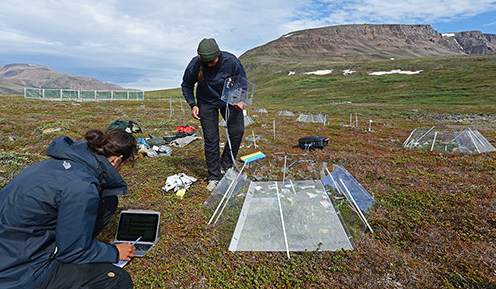Uptake of methane in Greenlandic heath
Methane is a potent greenhouse gas that is naturally produced and consumed in soil. These processes make that soils can function as a sink of atmospheric methane.

In-situ measurements of methane uptake in Blæsedalen (Disko Island) in West Greenland in 2017.
To address the importance of variability and drivers of methane uptake in dry heath tundra ecosystems, authors from the Center for Permafrost (CENPERM) have measured methane fluxes and soil characteristics under ambient and experimental warming conditions at low and high elevation sites in South (61°N) and West (69°N) Greenland. They then used a structural equation model to explain methane fluxes in relation to air temperatures and soil moisture. The authors see that soils across all sites were almost universal net methane sinks and that observed soil methane fluxes were significantly positively correlated to soil temperatures at 5 cm depth and negatively correlated to soil moisture. Additional factors such as soil pH and disturbance could also help to explain the differences in methane fluxes between similar dry heath sites across greater spatial scales. Understanding the importance of these factors is likely critical to more accurately upscale plot-level measurements of methane fluxes in constraining the terrestrial high latitude methane sink.
Original article
St. Pierre, K.A., Kortegaard Danielsen, B., Hermesdorf, L., D’Imperio, L., Lønsmann Iversen, L., Elberling, B., 2019. Drivers of net methane uptake across Greenlandic dry heath tundra landscapes. Soil Biology and Biochemistry, 138, 107605, doi: 10.1016/j.soilbio.2019.107605.
